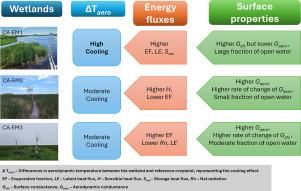加拿大草原坑区湿地的地表冷却潜力
IF 5.7
1区 农林科学
Q1 AGRONOMY
引用次数: 0
摘要
湿地具有固碳、调节气候、生物多样性和改善水质等多种生态系统功能。通过蒸发冷却,湿地生态系统还通过创造有益于当地动植物的小气候,在调节当地和区域气候方面发挥重要作用。在本研究中,通过考察加拿大草原坑穴地区湿地与附近农田之间的空气动力温度(Taeroaero)差异来评估湿地的降温效果。冷却效应是指通过环境的蒸散发和热耗散来降低空气或地表温度。我们利用了三种不同湿地和两种农田类型在2021-2023年间通过涡动相关方差测量收集的湍流通量和气象数据。我们的研究结果表明,在生长季节(5月至9月),湿地的温度明显低于农田,平均白天降温(Taeroaero reduction)在1.4°C至3.0°C之间。在热天(气温25°C),有更多开阔水域的湿地提供了更大的冷却作用,与附近的农田相比,温度降低了5.4°C。每个湿地都具有独特的生物物理特性,如表面和空气动力学导率,这导致不同的能量通量动力学产生不同的驱动白天冷却的机制。与农田相比,较高的蒸发分数强烈地推动了湿地的降温效应。这些结果强调了湿地显著的降温潜力,并强调了它们在调节当地和区域气候方面的重要性,最终有助于理解湿地的保护、恢复和管理如何有助于自然气候解决方案。本文章由计算机程序翻译,如有差异,请以英文原文为准。

Surface cooling potential of wetlands across the Prairie Pothole Region of Canada
Wetlands provide many ecosystem services such as carbon sequestration, climate regulation, biodiversity and water quality enhancement. Through evaporative cooling, wetland ecosystems also play a significant role in the regulation of local and regional climate by creating microclimates, which benefit local flora and fauna. In this study, the cooling effect of wetlands was evaluated by examining the differences in aerodynamic temperature (T) between wetlands and nearby croplands in the Prairie Pothole Region of Canada. The cooling effect refers to the reduction of air or surface temperature through evapotranspiration and thermal dissipation from the environment. We utilized turbulent flux and meteorological data gathered through eddy covariance measurements over three years (2021–2023) from three distinct wetland sites and two cropland types. Our findings reveal that during the growing season (May to September), wetlands exhibit significantly lower temperatures compared to the croplands, with mean daytime cooling (T reduction) ranging from 1.4 °C to 3.0 °C. On hot days (air temperature 25 °C), wetlands with more open water provided even greater cooling, reducing temperatures by up to 5.4 °C compared to nearby croplands. Each wetland is characterized by unique biophysical properties such as surface and aerodynamic conductances, which result in distinct energy flux dynamics generating different mechanisms driving the daytime cooling. Higher evaporative fraction strongly drives the cooling effect in wetlands compared to croplands. These results underscore the notable cooling potential of wetlands and highlight their importance in regulating local and regional climates, ultimately contributing to the understanding of how wetland conservation, restoration and management can contribute to natural climate solutions.
求助全文
通过发布文献求助,成功后即可免费获取论文全文。
去求助
来源期刊
CiteScore
10.30
自引率
9.70%
发文量
415
审稿时长
69 days
期刊介绍:
Agricultural and Forest Meteorology is an international journal for the publication of original articles and reviews on the inter-relationship between meteorology, agriculture, forestry, and natural ecosystems. Emphasis is on basic and applied scientific research relevant to practical problems in the field of plant and soil sciences, ecology and biogeochemistry as affected by weather as well as climate variability and change. Theoretical models should be tested against experimental data. Articles must appeal to an international audience. Special issues devoted to single topics are also published.
Typical topics include canopy micrometeorology (e.g. canopy radiation transfer, turbulence near the ground, evapotranspiration, energy balance, fluxes of trace gases), micrometeorological instrumentation (e.g., sensors for trace gases, flux measurement instruments, radiation measurement techniques), aerobiology (e.g. the dispersion of pollen, spores, insects and pesticides), biometeorology (e.g. the effect of weather and climate on plant distribution, crop yield, water-use efficiency, and plant phenology), forest-fire/weather interactions, and feedbacks from vegetation to weather and the climate system.

 求助内容:
求助内容: 应助结果提醒方式:
应助结果提醒方式:


